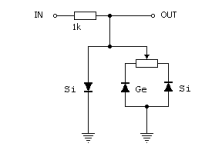radam84
Member
So I plan on building a RAT and have a turbo RAT layout I was going to follow. I decided that I was going to use a switch for different clipping options, but then thought about a pot and if that would work. So would a pot work for blending in-between differnt diode pairs? If someone tells me that it would work Im sure I can figure out how to wire it up myself, I guess Im also curious if it would a good idea or bad idea as in functionally as well. What I'm hoping I guess is that at zero Id have just LED clipping and then at full CW I have something else(not sure what diodes Id use yet) and then everything in-between would be something A-symmetrical. Do I have that right? I havent actually built anything yet so still researching and learning whats possible.



